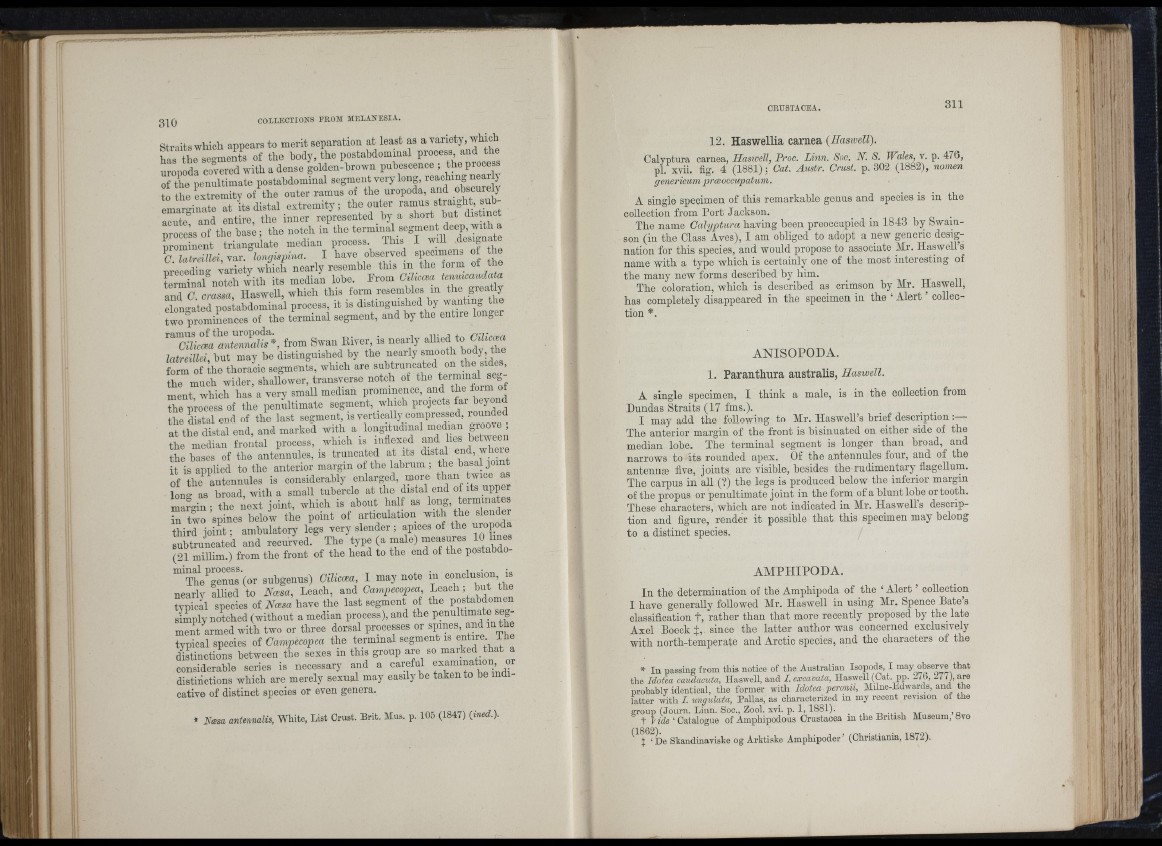
f ü
11
310 COLLECTIONS FROM MELANESIA.
Straits which appears to merit separation at least as a variety, which
has the seo-ments of the body, the postahdominal process and the
uropoda covered with a dense golden-brown pubescence ; process
of the penultimate postahdominal segment very long, reachin ne j
to the L trem ity of the outer ramus of the uropoda, and obscurely
e m a r ^ n l at L distal extremity; the outer -m u s straight sub
acute and entire, the inner represented by a short hut distinct
nrocess of the ba se ; tho notch in tho terminal segment deep, with a
prominent triangulate median process. This I will designate
C latreillei, var. longispina. I have observed specimens oi the
nrecediuo' variety which nearly resemble this in the form of the
terminal” notch with its median lobe. Erom Gihccexi a
nnd C crassa Haswell, which this form resembles in the greatly
elono-ated postahdominal process, it is distinguished by wanting the
two promiimnces of the terminal segment, and by the entire longer
from Swan Biver is nearly
latreillei but may he distinguished by the nearly smooth body, the
form of the thoracic segments, which are suhtruncated on the
the much wider, shaBower, transverse notch of the terminal se -
ment which has a very small median prominence, and the form of
the process of the penultimate segment, which projects beyond
the distal end of the last segment, is vertically compressed, rounded
at the distal end, and marked with a longitudinal median groove ,
median fro lta l process, which is inflexed and lies between
the bases of the antennules, is truncated at its distal end, where
it is applied to the anterior margin of the labrum ; the hasal jo
of the antennules is considerably enlarged, more th an twice as
lono- as broad, with a small tubercle at tho distal end of its upper
margin • tho next joint, which is about half as long, terminates
in tw o ’spines below the point of articulation ^^^h the slender
third jo in t; ambulatory legs very slender; apices of the uropoda
Bubtruncate'd and recurved. The type (a male)
(21 millim.) from the front of the head to the end of the postahdo
“ 'ThV'genus‘(or subgenus) Ciliccea, I may note in conclusión is
nearly allied to Ncesa, Leach, and Campecopea Leach ; but the
typical species of Ncesa have the last segment of the postabdomen
simply notched (without a median process), and the penultimate segment
armed with two or three dorsal processes or spines, ^ n d in th e
typical species of Campecopea the terminal segment is entire ih e
distinctions between the sexes in this group are so marked th at a
considerable series is necessary and a careful
disti¿ctions which are merely sexual may easily he taken to be indicative
of distinct species or even genera.
* N<esa antennalis, White, List Crust. Brit. Mus. p. 105 (1847) {ined.).
12. Haswellia carnea {Haswell).
Calvptura carnea, Hasivell, Proc. Linn. Sac. N. S. Wales, v. p. 476,
pi. xvii. fig. 4 (1881); Cat. Austr. Crust, p. 302 (1882), nomen
genericum prceoccupatum.
A single specimen of this remarkable genus and species is in the
collection from Port Jackson.
The name Galyptura having been preoccupied in 1843 by Swain-
son (in the Class Aves), I am obliged to adopt a new generic designation
for this species, and would propose to associate Mr. Haswell’s
name with a typo which is certainly one of the most interesting of
the many new forms described by him.
The coloration, which is described as crimson by Mr. Haswell,
has completely disappeared in the specimen in the ‘ Alert ’ collection
*.
ANISOPODA.
1. Paranthura australis, Haswell.
A single specimen, I think a male, is in the collection from
Dundas Straits (17 fms.). . _
I may add the following to Mr. HaswelPs brief description
The anterior margin of the front is bisinuated on either side of the
median lobe. The terminal segment is longer than broad, and
narrows to -its rounded apex. Of the antennules four, and of the
antennæ five, joints are visible, besides the rudimentary flagellum.
The carpus in all (?) the legs is produced below the inferior margin
of the propus or penultimate joint in the form of a blunt lobe or tooth.
These characters, which are not indicated in Mr. Haswell s description
and figure, render it possible th at this specimen may belong
to a distinct species.
AMPHIPODA.
In the determination of thé Amphipoda of the ‘ Alert ’ collection
I have generally followed Air. Haswell in using Air. Spence Bate s
classification t , rather than that more recently proposed by the late
Axel Boeck J, since the latter author was concerned exclusively
with north-temperate and Arctic species, and the characters of the
* In passing from this notice of the Australian Isopods, I may observe that
the Idotea cauclacuta, Haswell, and I. excavata, Haswell (Oat. pp. 276, 277), are
probably identical, the former with Idotea peronii, Milne-Ldwards, and the
latter with I. ungulata, Pallas, as _ characterized in my recent revision ot the
group (Journ. Linn. Soc., Zool. xvi. p. 1, 1881). _ , -r> i im- >q
t Uas ‘ Catalogue of Amphipodous Crustacea in the British Museum. 8vo
M
1 .Í
I '-
• ' ;
,il